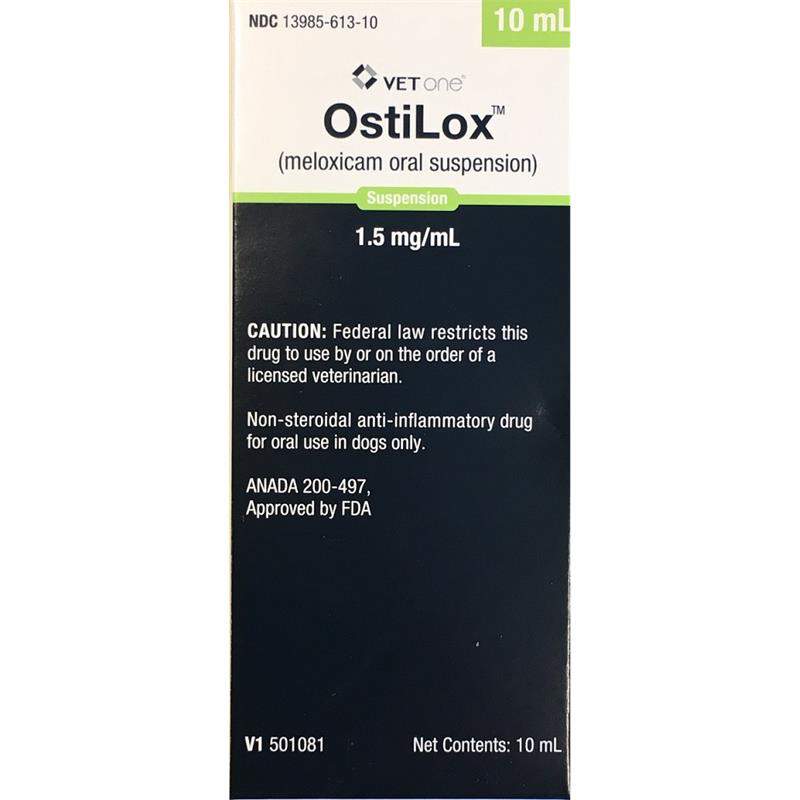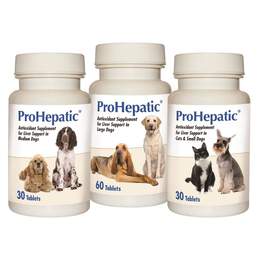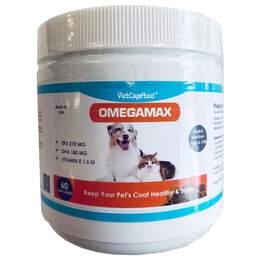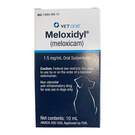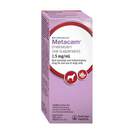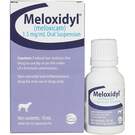

Click on image to open expanded view
Item No.
51378
Ostilox (Meloxicam 1.5 mg/ml) Oral Suspension for Dogs Rx

Availability:
-
In Stock
AutoShip & Save 20%
Size:
Product Description
Ostilox (Meloxicam 1.5 mg/ml) Oral Suspension is a non-steroidal anti-inflammatory (NSAID) indicated for the control of pain and inflammation associated with osteoarthritis in dogs. It is available in 10 ml, 32 ml or 100 ml bottles.
What is Ostilox (Meloxicam 1.5 mg/ml) Oral Suspension for Dogs?
Ostilox (Meloxicam 1.5 mg/ml) Oral Suspension is indicated for the control of pain and inflammation associated with osteoarthritis in dogs.
Who is Ostilox (Meloxicam 1.5 mg/ml) Oral Suspension for Dogs for?
Dogs (6 months of age and older)
Why use Ostilox (Meloxicam 1.5 mg/ml) Oral Suspension for Dogs?
-Helps control pain and inflammation associated with osteoarthritis in dogs
-Easy to use oral suspension
How does Ostilox (Meloxicam 1.5 mg/ml) Oral Suspension for Dogs work?
Metacam works by reducing hormones that cause pain and inflammation in the body
Manufacturer:
VetOne
Active Ingredients(s):
Meloxicam 1.5 mg/ml
How is Ostilox (Meloxicam 1.5 mg/ml) Oral Suspension for Dogs sold?
10 ml, 32 ml or 100 ml bottles with small and large dosing syringes
What are the side effects of Ostilox (Meloxicam 1.5 mg/ml) Oral Suspension for Dogs?
GI abnormalities (vomiting, soft stools, diarrhea, and inappetance) were the most common adverse reactions associated with the administration of meloxicam.
What special precautions are there?
Keep away from children and animals. Precautions : The safe use of OstiLox Oral Suspension in dogs younger than 6 months of age, dogs used for breeding, or in pregnant or lactating dogs has not been evaluated. Meloxicam is not recommended for use in dogs with bleeding disorders, as safety has not been established in dogs with these disorders. As a class, cyclo-oxygenase inhibitory NSAIDs may be associated with gastrointestinal, renal and hepatic toxicity. Sensitivity to drug-associated adverse events varies with the individual patient. Dogs that have experienced adverse reactions from one NSAID may experience adverse reactions from another NSAID. Patients at greatest risk for renal toxicity are those that are dehydrated, on concomitant diuretic therapy, or those with existing renal, cardiovascular, and/or hepatic dysfunction. Concurrent administration of potentially nephrotoxic drugs should be carefully approached. NSAIDs may inhibit the prostaglandins that maintain normal homeostatic function. Such anti-prostaglandin effects may result in clinically significant disease in patients with underlying or pre-existing disease that has not been previously diagnosed. Since NSAIDs possess the potential to induce gastrointestinal ulcerations and/or perforations, concomitant use with other anti-inflammatory drugs, such as NSAIDs or corticosteroids, should be avoided. If additional pain medication is needed after administration of the total daily dose of OstiLox Oral Suspension, a non-NSAID or non-corticosteroid class of analgesia should be considered. The use of another NSAID is not recommended. Consider appropriate washout times when switching from corticosteroid use or from one NSAID to another in dogs. The use of concomitantly protein-bound drugs with OstiLox Oral Suspension has not been studied in dogs. Commonly used protein-bound drugs include cardiac, anticonvulsant and behavioral medications. The influence of concomitant drugs that may inhibit metabolism of OstiLox Oral Suspension has not been evaluated. Drug compatibility should be monitored in patients requiring adjunctive therapy. Warnings Not for use in humans. Consult a physician in case of accidental ingestion by humans. For oral use in dogs only. As with any NSAID all dogs should undergo a thorough history and physical examination before the initiation of NSAID therapy. Appropriate laboratory testing to establish hematological and serum biochemical baseline data is recommended prior to and periodically during administration. Owner should be advised to observe their dog for signs of potential drug toxicity and be given a client information sheet about OstiLox. Contraindications Dogs with known hypersensitivity to meloxicam should not receive OstiLox Oral Suspension. Do not use OstiLox Oral Suspension in cats. Acute renal failure and death have been associated with the use of meloxicam in cats.
What to do if overdose?
Contact your nearest emergency animal hospital
How can I store Ostilox (Meloxicam 1.5 mg/ml) Oral Suspension for Dogs?
Store at controlled room temperature 68-77°F (20-25°C). Excursions permitted between 59°F and 86°F (15°C and 30°C). Brief exposure to temperature up to 104°F (40°C) may be tolerated provided the mean kinetic temperature does not exceed 77°F (25°C); however such exposure should be minimized.
Overview
Use as directed by your Veterinarian
Dosage and Administration
Always provide client information sheet with prescription. Carefully consider the potential benefits and risk of OstiLox Oral Suspension and other treatment options before deciding to use OstiLox Oral Suspension. Use the lowest effective dose for the shortest duration consistent with individual response. OstiLox Oral Suspension should be administered initially at 0.09 mg/lb (0.2 mg/kg) body weight only on the first day of treatment. For all treatments after day 1, OstiLox Oral Suspension should be administered once daily at a dose of 0.045 mg/lb (0.1 mg/kg). The syringes are calibrated to deliver the daily maintenance dose in lbs. Because the first dose (0.2 mg/kg) is two times the amount of the daily maintenance dose (0.1 mg/kg), two syringes containing the 0.1 mg/kg dose should be administered at the first dose.
Directions for Administration:
OstiLox Oral Suspension is packaged with 2 sizes of dosing syringes. The small syringe is calibrated in 1-lb increments for use in dogs under 30 lbs. The large syringe is calibrated in 5-lb increments (up to 160 lbs.) and should be used for dosing dogs that are 30 lbs and over. Only administer OstiLox with the provided syringes. The container should never be used as a dropper bottle for administration of OstiLox.
Dogs Under 30 Lbs (13.6 Kg)
Shake well before use, then remove cap. OstiLox Oral Suspension can be given either mixed with food or placed directly into the mouth. Particular care should be given with regard to the accuracy of dosing. To prevent accidental overdosing of small dogs, only use the small dosing syringe. The large syringe provided should not be used to measure doses for dogs weighing less than 30 lbs (13.6 kg). For dogs under 30 lbs, use the small dosing syringe provided in the package (see dosing procedure below). The small dosing syringe fits onto the bottle and has dosing marks in 1-lb increments, designed to deliver the daily maintenance dose of 0.045 mg/lb (0.1 mg/kg). For dogs between 1 - 29 lbs, OstiLox can be given using the marks on the small dosing syringe. When using the small dosing syringe, the dog’s weight should be rounded down to the nearest 1-lb increment. Replace and tighten cap after use.
Dogs 30 Lbs (13.6 Kg) And Over
Shake well before use, then remove cap. OstiLox may be either mixed with food or placed directly into the mouth. Particular care should be given with regard to the accuracy of dosing. To prevent accidental overdosing of small dogs, do not use the large syringe in animals weighing less than 30 pounds. For dogs 30 lbs or greater, the large dosing syringe provided in the package should be used (see dosing procedure below). The large dosing syringe fits onto the bottle and has dosing marks in 5-lb increments (up to 160 lbs), designed to deliver the daily maintenance dose of 0.045 mg/lb (0.1 mg/kg). When using the large syringe, the dog’s weight should be rounded down to the nearest 5-lb increment. Replace and tighten cap after use.
Main Ingredients
Meloxicam 1.5 mg/ml


